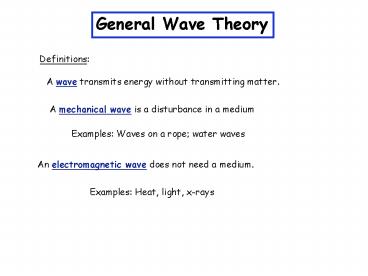PowerPoint Presentation Plancks Quantization of Energy 1900
1 / 20
Title: PowerPoint Presentation Plancks Quantization of Energy 1900
1
General Wave Theory
Definitions
A wave transmits energy without transmitting
matter.
A mechanical wave is a disturbance in a medium
Examples Waves on a rope water waves
An electromagnetic wave does not need a medium.
Examples Heat, light, x-rays
2
A Transverse Wave
Frequency The number of waves per unit of time
3
The Wave Equation
Wavelength has the symbol l units of meters/wave
Frequency has the symbol n units of waves/sec
A frequency of 1 wave/sec is called 1 Hertz (Hz)
n
wave velocity
l
m
m
waves
wave
s
s
4
Using the Wave Equation
n
wave velocity
l
A sound wave with a frequency of 440 Hz has a
wavelength of 0.800 m. Find the speed of sound.
(0.800 m)
(440 1/s)
352 m/s
5
Using the Wave Equation
n
wave velocity
l
What is the frequency of a sound wave that has a
wavelength of 0.400 m. The speed of sound is 352
m/s
n
(0.400 m)
352 m/s
352 m/s
880 1/s
n
0.400 m
880 Hz
6
Using the Wave Equation
For electromagnetic radiation, the velocity of
the wave is the speed of light, c
n
c
l
C 3.00 x 108 m/s
7
The Electromagnetic Spectrum
8
Using the Wave Equation
n
c
l
What is the frequency of a light wave that has a
wavelength of 400 nm?
400 nm 400 x 10-9 m 4.00 x 10-7 m
n
(4.00 x 10-7 m )
3.0 x 108 m/s
3.0 x 108 m/s
n
7.5 x 1014 Hz
4.00 x 10-7 m
9
Plancks Quantization of Energy (1900)
Energy a frequency
Energy is quantized according to
E n (hn)
Where h (Plancks constant) 6.63 x 10-34 J. s
and n must be an integer.
(hn) represents a packet of energy also called
a quantum of energy or a photon
10
Using Plancks Equation
E n (hn)
What is the energy of a photon of light that has
a frequency of 7.5 x 1014 Hz?
h 6.63 x 10-34 J. s
n is usually equal to 1
E
(6.63 x 10-34 J. s)
7.5 x 1014 1/s
E
4.97 x 10-19 J
11
Three Types of Spectra
12
The emission spectrum of hydrogen
13
J.J. Balmer and J.R. Rydberg and A. Einstein
1885 J.J. Balmer finds that the spectrum of
hydrogen follows a precise mathematical relation
1890 J.R. Rydberg extends Balmers formula to
include hydrogen spectral lines at other
wavelengths and some other elements.
1905 Einstein uses Plancks equation to solve an
urelated problem the photoelectric effect.
This showed that Plancks ideas were correct.
14
(No Transcript)
15
1913 Niels Bohr
Three Part Theory
1. Classical planetary picture of the atom.
2. Quantum Assumption The electron can only be
in certain orbits (energy levels) around the
nucleus
3. Transitions between energy levels An electron
in an atom absorbs or emits energy by undergoing
a transition from one energy level to another.
16
The Bohr Equation
Bohr derived the following formula for the energy
levels of the electron in the hydrogen atom
-RH
En
n2
RH is a constant with a value of 2.18 x 10-18 J.
(for H only)
17
Transitions in the Bohr Atom
When an electron falls from n 3 to n 2 energy
level, a photon of red light (l 685 nm) is
emitted
When red light of this same wavelength shines on
a hydrogen atom in the n 2 level, the energy is
gained by the electron that undergoes a
transition to n 3.
18
(No Transcript)
19
(No Transcript)
20
Transitions in the Hydrogen Atom































